TOYOTA FJ CRUISER 2012 1.G Owners Manual
Manufacturer: TOYOTA, Model Year: 2012, Model line: FJ CRUISER, Model: TOYOTA FJ CRUISER 2012 1.GPages: 540, PDF Size: 10.32 MB
Page 141 of 540
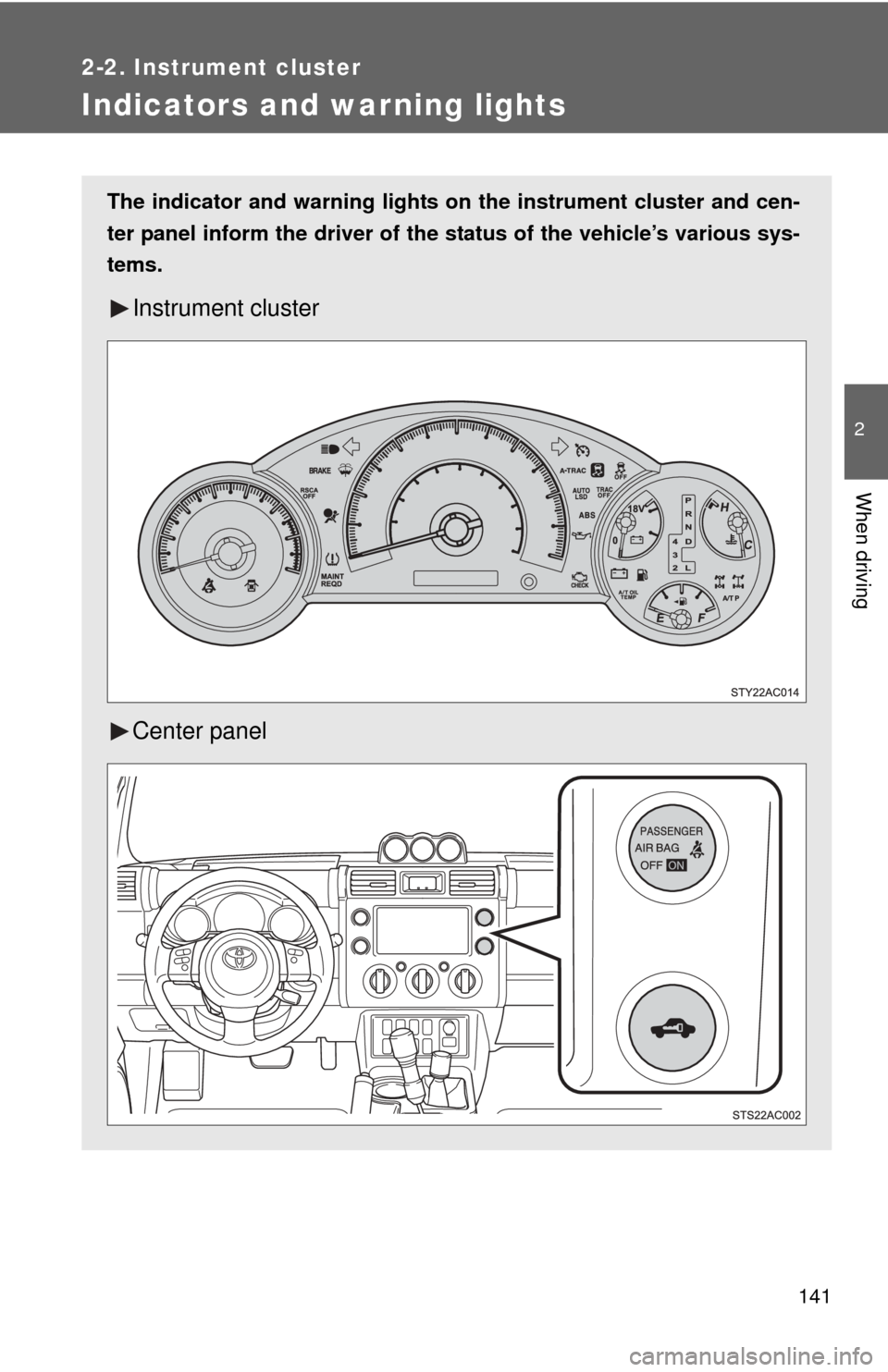
141
2-2. Instrument cluster
2
When driving
Indicators and warning lights
The indicator and warning lights on the instrument cluster and cen-
ter panel inform the driver of the status of the vehicle’s various sys-
tems.
Instrument cluster
Center panel
Page 142 of 540
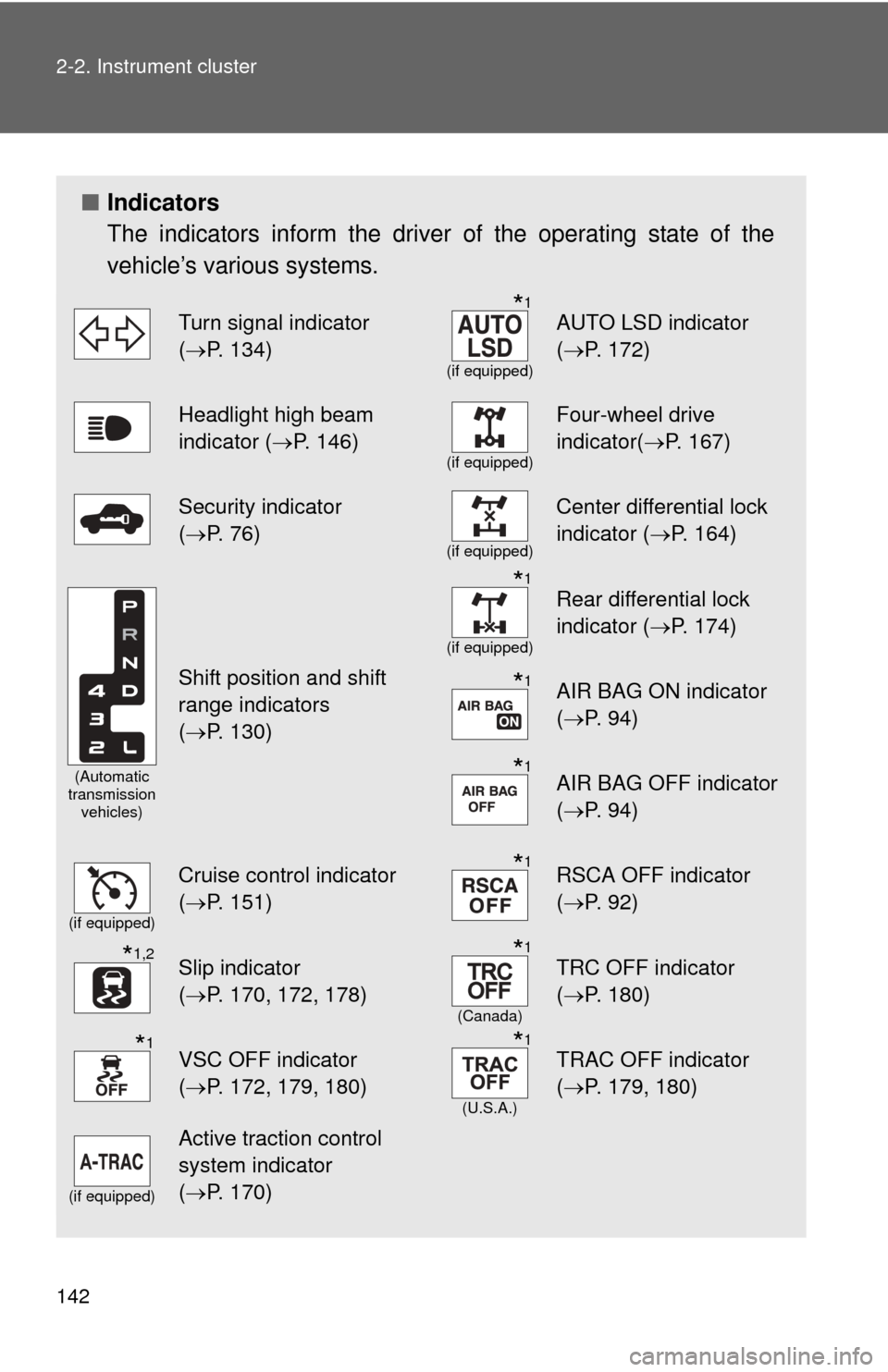
142 2-2. Instrument cluster
â– Indicators
The indicators inform the driver of the operating state of the
vehicle’s various systems.
Turn signal indicator
(ď‚®P. 134)*1
(if equipped)
AUTO LSD indicator
( ď‚®P. 172)
Headlight high beam
indicator ( ď‚®P. 146)
(if equipped)
Four-wheel drive
indicator(ď‚®P. 167)
Security indicator
(ď‚®P. 76)
(if equipped)
Center differential lock
indicator ( ď‚®P. 164)
(Automatic
transmission vehicles)
Shift position and shift
range indicators
(ď‚®P. 130)
*1
(if equipped)
Rear differential lock
indicator ( ď‚®P. 174)
*1AIR BAG ON indicator
(ď‚®P. 94)
*1AIR BAG OFF indicator
(ď‚®P. 94)
(if equipped)
Cruise control indicator
(ď‚®P. 151)*1RSCA OFF indicator
( ď‚®P. 92)
*1,2Slip indicator
(ď‚®P. 170, 172, 178)*1
(Canada)
TRC OFF indicator
( ď‚®P. 180)
*1VSC OFF indicator
(ď‚®P. 172, 179, 180)*1
(U.S.A.)
TRAC OFF indicator
( ď‚®P. 179, 180)
(if equipped)
Active traction control
system indicator
(ď‚®P. 170)
Page 143 of 540
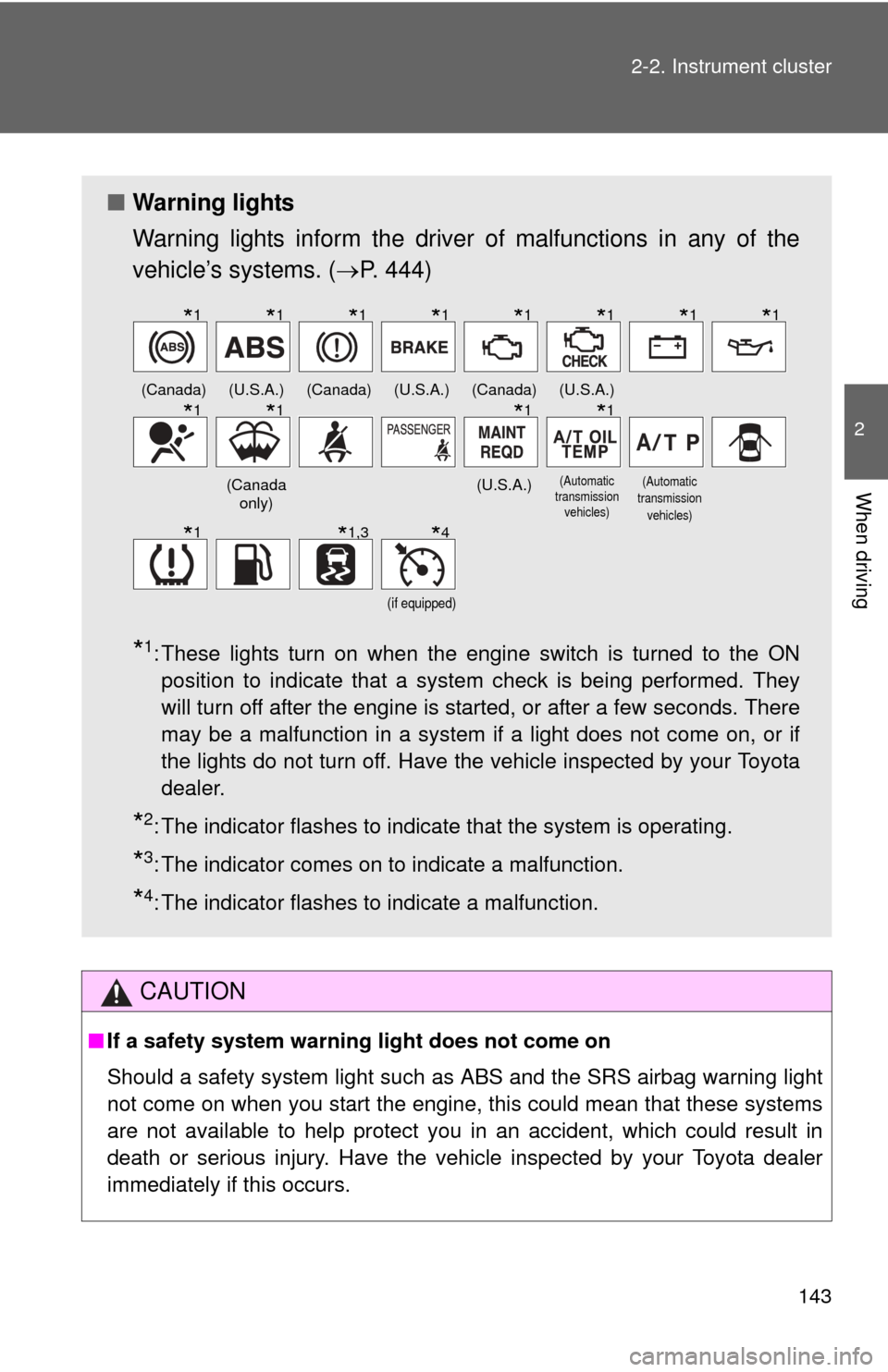
143
2-2. Instrument cluster
2
When driving
CAUTION
â–
If a safety system warning light does not come on
Should a safety system light such as ABS and the SRS airbag warning light
not come on when you start the engine, this could mean that these systems
are not available to help protect you in an accident, which could result in
death or serious injury. Have the vehicle inspected by your Toyota dealer
immediately if this occurs.
â– Warning lights
Warning lights inform the driver of malfunctions in any of the
vehicle’s systems. ( P. 444)
*1: These lights turn on when the engine switch is turned to the ON
position to indicate that a system check is being performed. They
will turn off after the engine is started, or after a few seconds. There
may be a malfunction in a system if a light does not come on, or if
the lights do not turn off. Have the vehicle inspected by your Toyota
dealer.
*2: The indicator flashes to indicate that the system is operating.
*3: The indicator comes on to indicate a malfunction.
*4: The indicator flashes to indicate a malfunction.
(Canada)(U.S.A.)(Canada)(U.S.A.)(Canada)(U.S.A.)
(Canada only)(U.S.A.)
(Automatic
transmission
vehicles)(Automatic
transmission vehicles)
(if equipped)
*1*1*1*1*1*1*1*1
*1*1*1*1
*1*1,3*4
Page 144 of 540
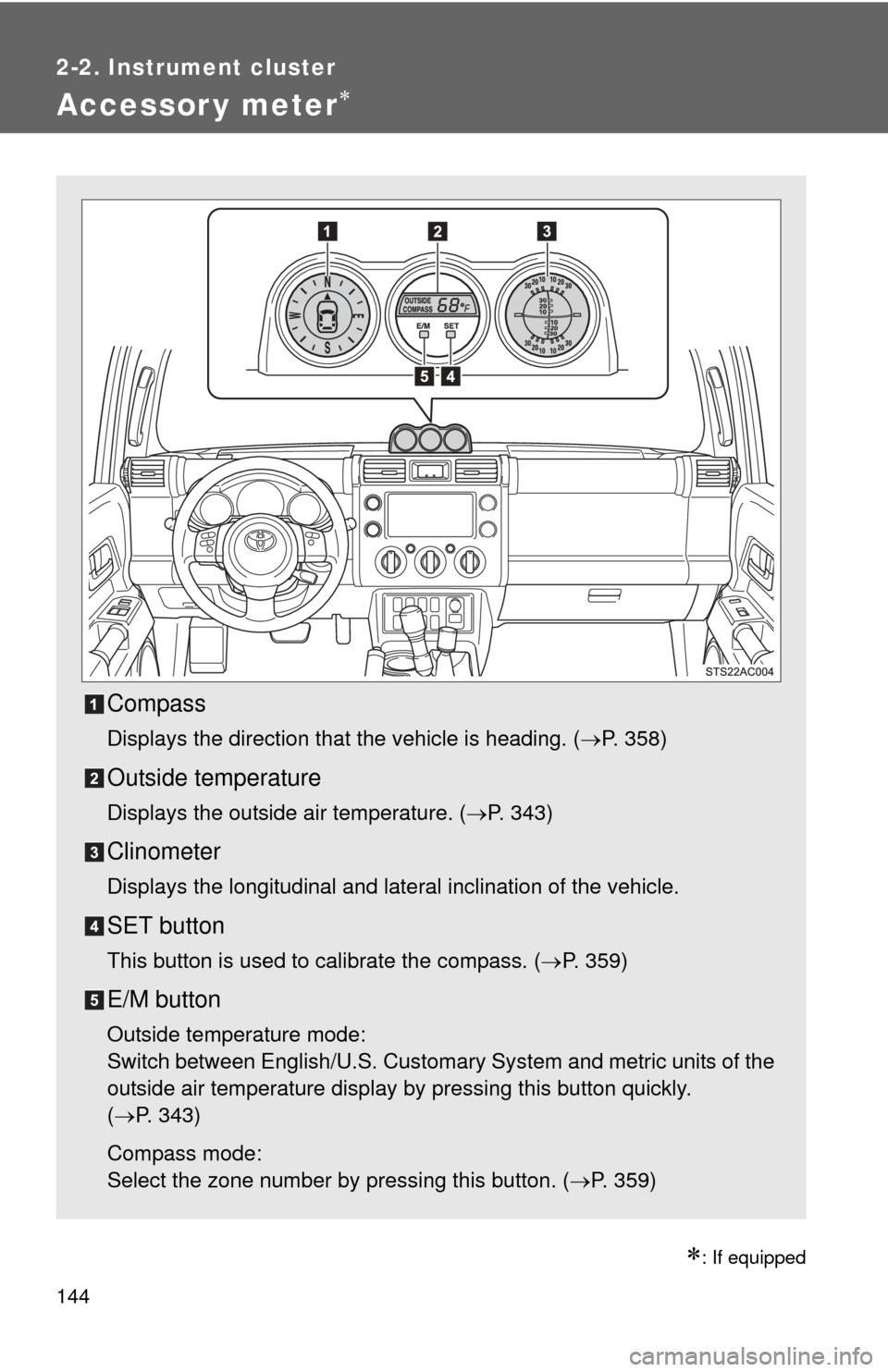
144
2-2. Instrument cluster
Accessor y meter
: If equipped
Compass
Displays the direction that the vehicle is heading. (ď‚®P. 358)
Outside temperature
Displays the outside air temperature. (ď‚®P. 343)
Clinometer
Displays the longitudinal and lateral inclination of the vehicle.
SET button
This button is used to calibrate the compass. ( ď‚®P. 359)
E/M button
Outside temperature mode:
Switch between English/U.S. Customary System and metric units of the
outside air temperature display by pressing this button quickly.
(ď‚®P. 343)
Compass mode:
Select the zone number by pressing this button. ( ď‚®P. 359)
Page 145 of 540

145
2-2. Instrument cluster
2
When driving
CAUTION
â–
Caution while driving
Do not adjust the display.
Doing so may cause the driver to mishandle the vehicle and cause an acci-
dent, resulting in death or serious injury.
Page 146 of 540
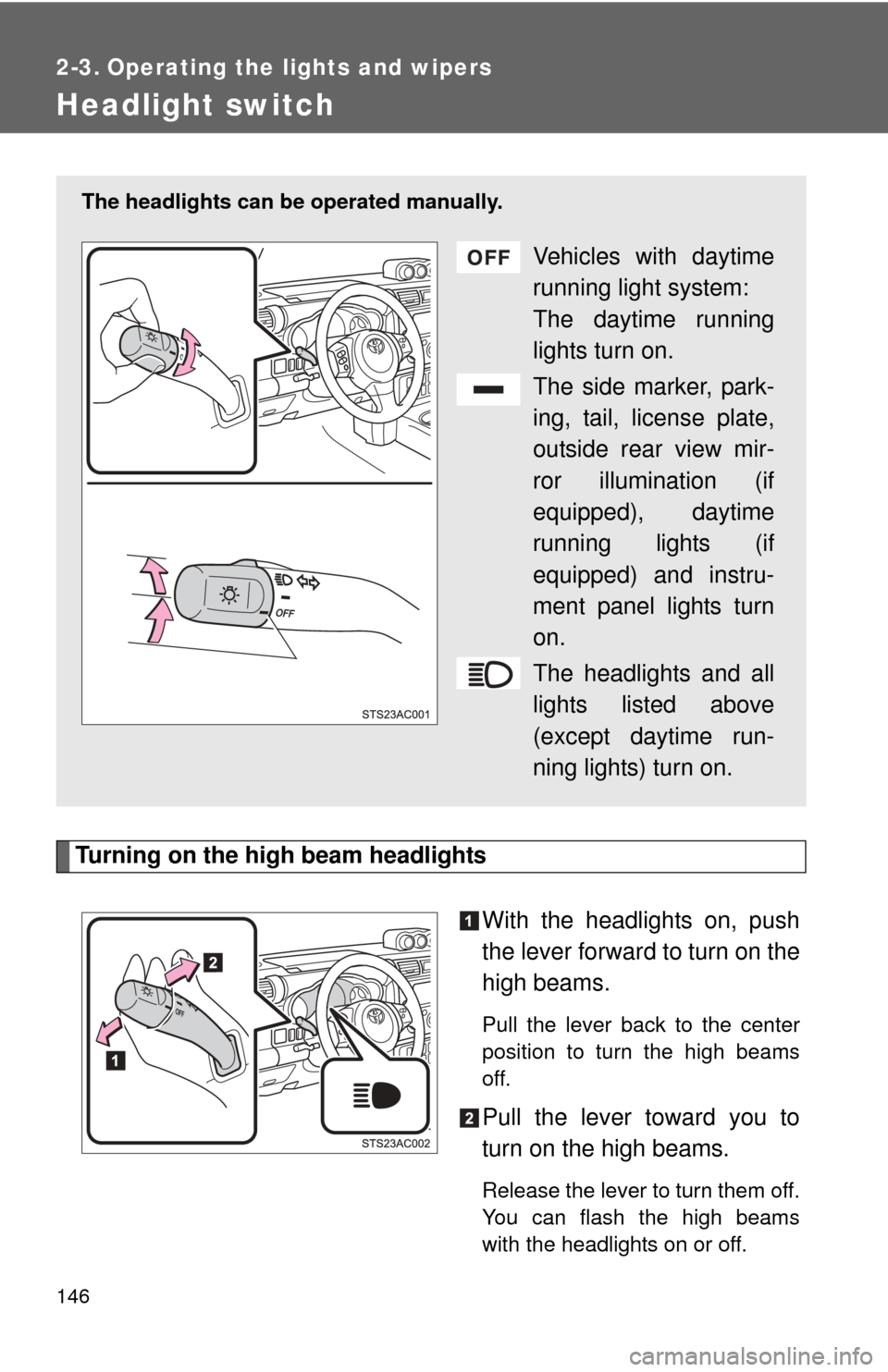
146
2-3. Operating the lights and wipers
Headlight switch
Turning on the high beam headlightsWith the headlights on, push
the lever forward to turn on the
high beams.
Pull the lever back to the center
position to turn the high beams
off.
Pull the lever toward you to
turn on the high beams.
Release the lever to turn them off.
You can flash the high beams
with the headlights on or off.
The headlights can be operated manually.
Vehicles with daytime
running light system:
The daytime running
lights turn on.
The side marker, park-
ing, tail, license plate,
outside rear view mir-
ror illumination (if
equipped), daytime
running lights (if
equipped) and instru-
ment panel lights turn
on.
The headlights and all
lights listed above
(except daytime run-
ning lights) turn on.
Page 147 of 540

147
2-3. Operating the lights and wipers
2
When driving
â–
Daytime running light system (if equipped)
â—ŹTo make your vehicle more visible to other drivers, the headlights turn on
automatically (at a reduced intensity) whenever the engine is started and
the parking brake is released. Daytime running lights are not designed for
use at night.
â—Ź Compared to turning on the headlights, the daytime running light system
offers greater durability and consumes less electricity, so it can help
improve fuel economy.
â– Automatic light off system
â—ŹWhen the headlights come on: The headlights and tail lights turn off 30
seconds after all doors and glass hatch are closed with the engine switch
turned to the ACC or LOCK position. (The lights turn off immediately if
the LOCK button on the wireless remote control is pressed twice after all
doors are locked.)
â—Ź When only the tail lights come on: The tail lights turn off automatically
with the engine switch turned to the ACC or LOCK position and the
driver’s door is opened.
If the driver’s door is kept open, the lights automatically turn off after 30 min-
utes.
To turn the lights on again, turn the engine switch to the ON position, or turn
the headlight switch off once and then back to the or position.
â– Customization that can be co nfigured at Toyota dealer
Settings (automatic light off system) can be changed. (Customizable
features ď‚® P. 507)
NOTICE
â– To prevent battery discharge
Do not leave the lights on longer than necessary when the engine is not run-
ning.
Page 148 of 540
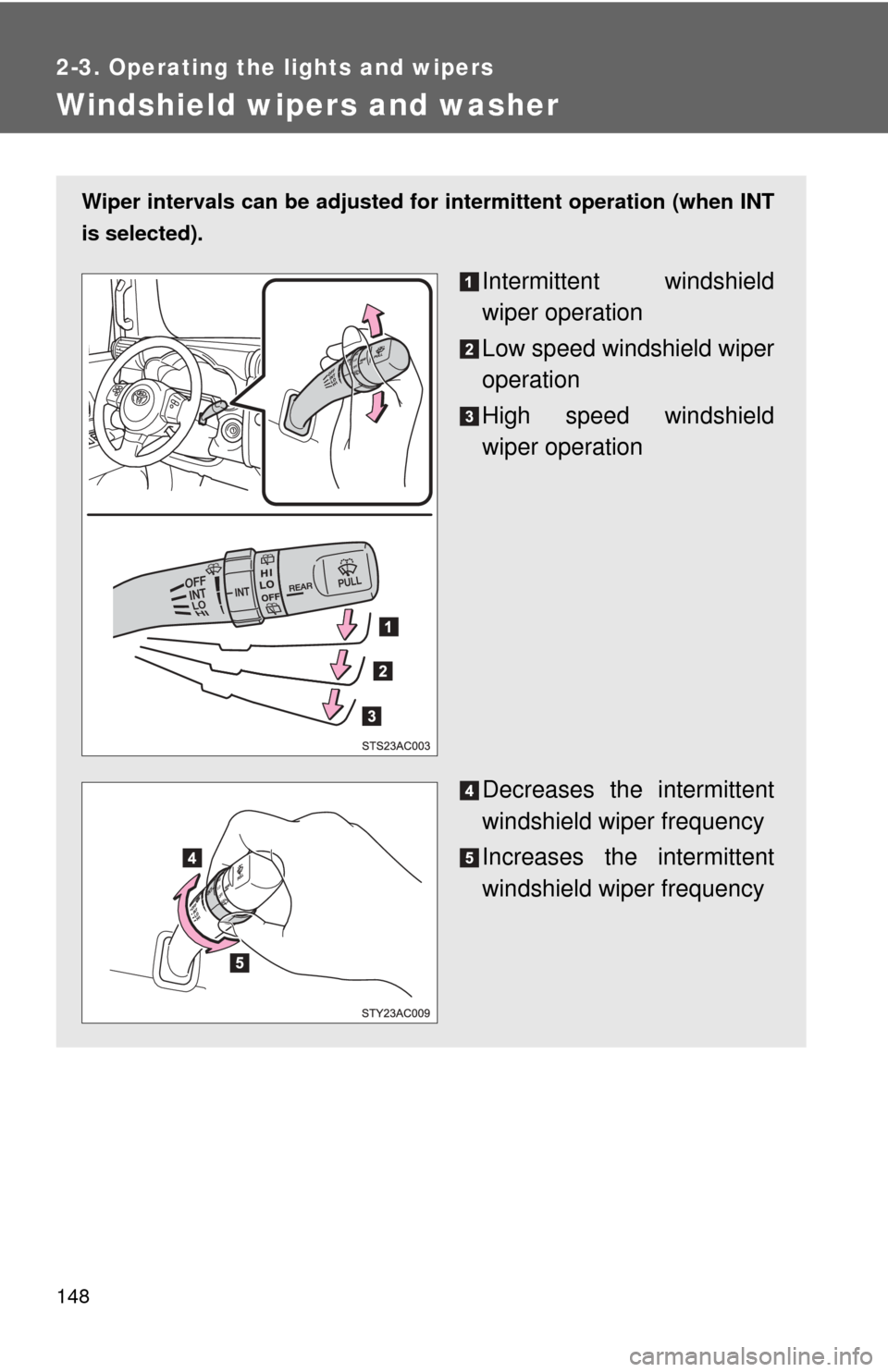
148
2-3. Operating the lights and wipers
Windshield wipers and washer
Wiper intervals can be adjusted for intermittent operation (when INT
is selected).
Intermittent windshield
wiper operation
Low speed windshield wiper
operation
High speed windshield
wiper operation
Decreases the intermittent
windshield wiper frequency
Increases the intermittent
windshield wiper frequency
Page 149 of 540
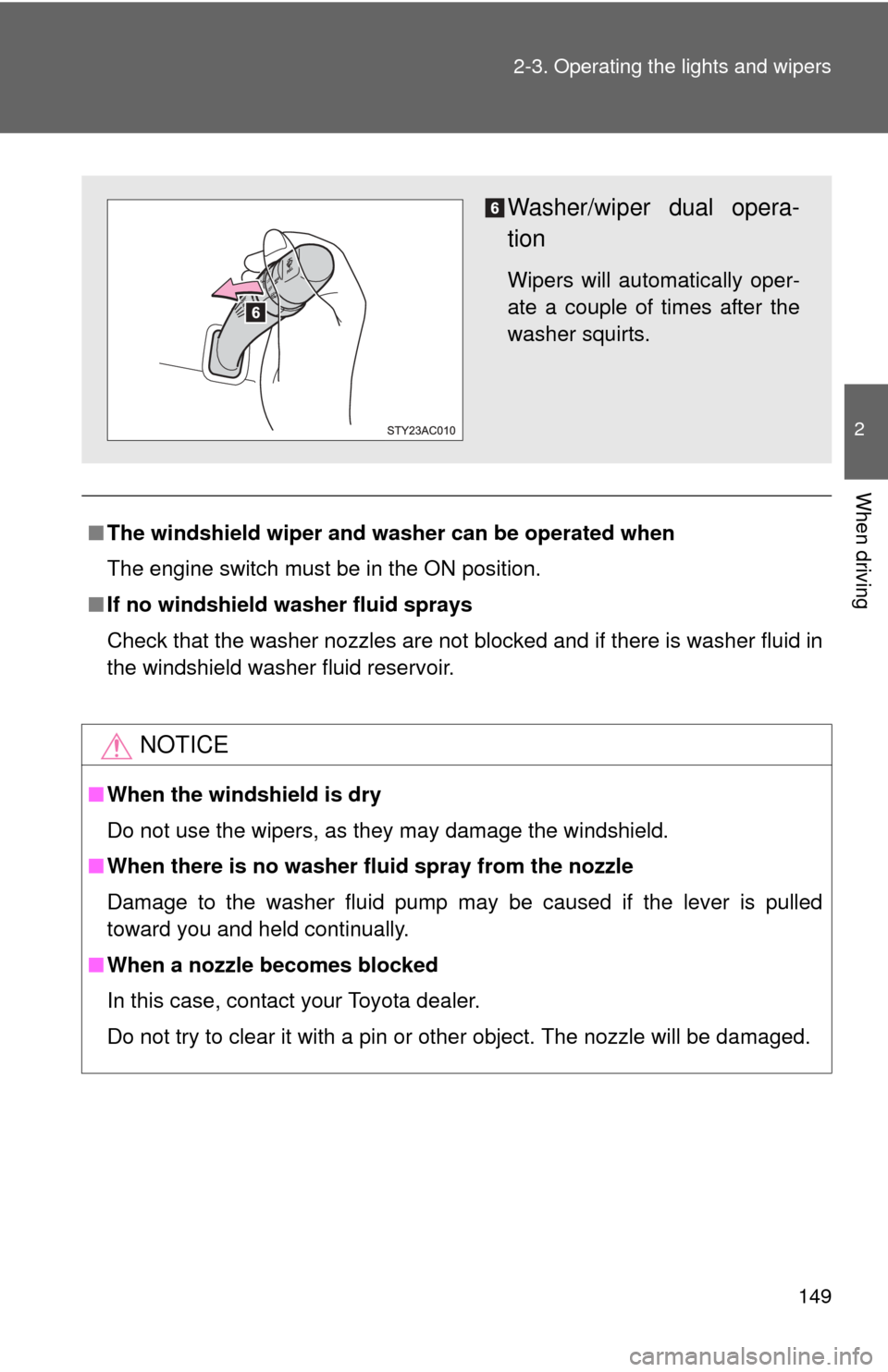
149
2-3. Operating the lights and wipers
2
When driving
â–
The windshield wiper and washer can be operated when
The engine switch must be in the ON position.
â– If no windshield washer fluid sprays
Check that the washer nozzles are not blocked and if there is washer fluid in
the windshield washer fluid reservoir.
NOTICE
â– When the windshield is dry
Do not use the wipers, as they may damage the windshield.
â– When there is no washer fluid spray from the nozzle
Damage to the washer fluid pump may be caused if the lever is pulled
toward you and held continually.
â– When a nozzle becomes blocked
In this case, contact your Toyota dealer.
Do not try to clear it with a pin or other object. The nozzle will be damaged.
Washer/wiper dual opera-
tion
Wipers will automatically oper-
ate a couple of times after the
washer squirts.
Page 150 of 540
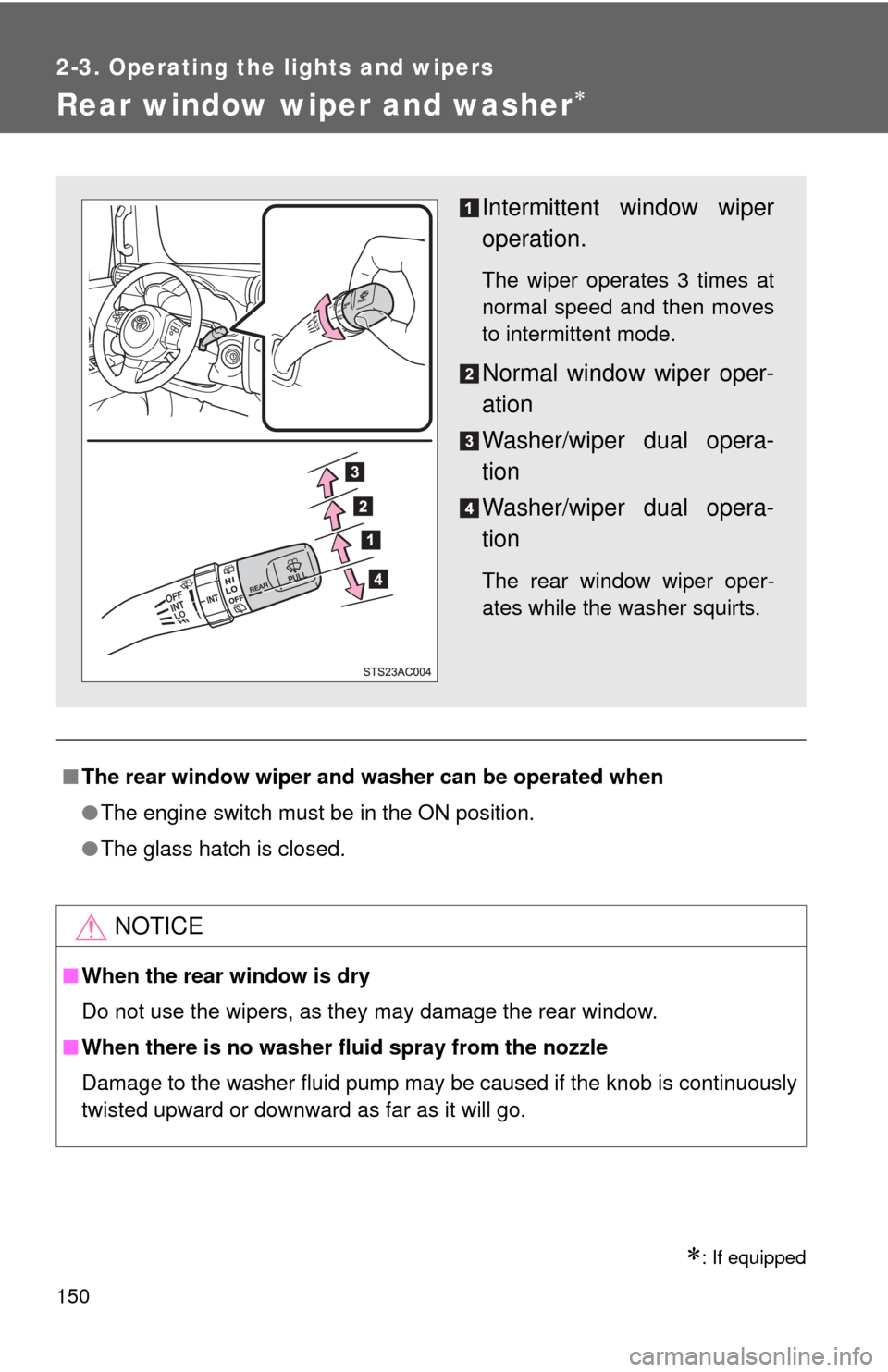
150
2-3. Operating the lights and wipers
Rear window wiper and washer
: If equipped
â– The rear window wiper and w asher can be operated when
â—Ź The engine switch must be in the ON position.
â—Ź The glass hatch is closed.
NOTICE
â– When the rear window is dry
Do not use the wipers, as they may damage the rear window.
â– When there is no washer fluid spray from the nozzle
Damage to the washer fluid pump may be caused if the knob is continuously
twisted upward or downward as far as it will go.
Intermittent window wiper
operation.
The wiper operates 3 times at
normal speed and then moves
to intermittent mode.
Normal window wiper oper-
ation
Washer/wiper dual opera-
tion
Washer/wiper dual opera-
tion
The rear window wiper oper-
ates while the washer squirts.